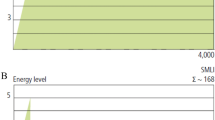Abstract
Purpose
To evaluate the association between being underweight and shockwave lithotripsy outcomes.
Methods
This retrospective two-centre cohort study conducted in Japan involved 597 patients diagnosed with a single urinary tract calculus based on computed tomography and who underwent shockwave lithotripsy between 2006 and 2016. We divided the patients into four groups based on their body mass index (underweight, ≤ 18.4; normal weight, 18.5–24.9; overweight, 25–29.9; obese, ≥ 30 kg/m2). We performed multivariable logistic regression analysis and estimated the odds ratio for success of single-session shockwave lithotripsy.
Results
Of the 597 patients, 25 (4.2%) were underweight and 34 (5.7%) were obese. After adjusting for age, sex, calculus localisation, maximum stone length, mean stone density, and skin-to-stone distance, being underweight showed a significantly negative association with success of single-session shockwave lithotripsy (odds ratio 0.25, 95% confidence interval 0.09–0.69) compared to being normal weight.
Conclusions
This study showed the negative impact of being underweight on the outcomes of shockwave lithotripsy in patients with upper urinary tract calculi. This finding provides a novel viewpoint regarding the body mass index and should aid improved treatment selection for patients with upper urinary tract calculi.

Similar content being viewed by others
References
Türk C, Petřík A, Sarica K et al (2016) EAU guidelines on interventional treatment for urolithiasis. Eur Urol 69:475–482
Surgical Management of Stones: AUA/endourology society guideline (2016). [Internet] https://www.auanet.org/guidelines/kidney-stones-surgical-management-guideline. Accessed 7 Sep 2019.
Drake T, Grivas N, Dabestani S et al (2017) What are the benefits and harms of ureteroscopy compared with shock-wave lithotripsy in the treatment of upper ureteral stones? A systematic review. Eur Urol 72:772–786
Bach C, Buchholz N (2011) Shock wave lithotripsy for renal and ureteric stones. Eur Urol Suppl 10:423–432
Choo MS, Uhmn S, Kim JK et al (2018) A prediction model using machine learning algorithm for assessing stone-free status after single session shock wave lithotripsy to treat ureteral stones. J Urol 200:1371–1377
Shu X, Cai H, Xiang YB et al (2017) Nephrolithiasis among middle aged and elderly urban Chinese: a report from prospective cohort studies in Shanghai. J Endourol 31:1327–1334
Nussberger F, Roth B, Metzger T, Kiss B, Thalmann GN, Seiler R (2017) A low or high BMI is a risk factor for renal hematoma after extracorporeal shock wave lithotripsy for kidney stones. Urolithiasis 45:317–321
Japanese Urological Association, Japanese Society of Endourology, Japanese Society of Urolithiasis Research (2013) Japanese Guideline on Urolithiasis 2nd edition. [Internet] https://minds.jcqhc.or.jp/n/med/4/med0022/G0000634/0021. Accessed 7 Sep 2019
Osman MM, Alfano Y, Kamp S et al (2005) 5-Year-follow-up of patients with clinically insignificant residual fragments after extracorporeal shockwave lithotripsy. Eur Urol 47:860–864
Türk C, Petřík A, Sarica K et al (2016) EAU guidelines on diagnosis and conservative management of urolithiasis. Eur Urol 69:468–474
Obesity and overweight. [Internet] https://www.who.int/news-room/fact-sheets/detail/obesity-and-overweight. Accessed 7 Sep 2019.
Underweight adults—NHS. [Internet] https://www.nhs.uk/live-well/healthy-weight/advice-for-underweight-adults/. Accessed 7 Sep 2019.
Yamashita S, Kohjimoto Y, Iwahashi Y et al (2018) Noncontrast computed tomography parameters for predicting shock wave lithotripsy outcome in upper urinary tract stone cases. Biomed Res Int 2018:9253952
Alexander CE, Gowland S, Cadwallader J et al (2016) Shock wave lithotripsy (SWL): outcomes from a national SWL database in New Zealand. BJU Int 117:76–81
Wiesenthal JD, Ghiculete D, Ray AA et al (2011) A clinical nomogram to predict the successful shock wave lithotripsy of renal and ureteral calculi. J Urol 186:556–562
Pareek G, Armenakas NA, Panagopoulos G, Bruno JJ, Fracchia JA (2005) Extracorporeal shock wave lithotripsy success based on body mass index and Hounsfield units. Urology 65:33–36
Hatiboglu G, Popeneciu V, Kurosch M et al (2011) Prognostic variables for shockwave lithotripsy (SWL) treatment success: no impact of body mass index (BMI) using a third generation lithotripter. BJU Int 108:1192–1197
Kroczak T, Scotland KB, Chew B, Pace KT (2017) Shockwave lithotripsy: techniques for improving outcomes. World J Urol 35:1341–1346
Merrill RM, Richardson JS (2009) Validity of self-reported height, weight, and body mass index: findings from the National Health and Nutrition Examination Survey, 2001–2006. Prev Chronic Dis 6:A121
Acknowledgements
We would like to thank Editage (www.editage.jp) for English language editing.
Funding
This study did not receive any financial support.
Author information
Authors and Affiliations
Contributions
Protocol/project development: T. Yoshioka, KO, T. Yamasaki, KF, HO, SU, MA, and SF. Data collection or management: T. Yoshioka, TK, YI, MS, T. Yamasaki, and HO. Data analysis: TY and KO. Manuscript writing/editing: T. Yoshioka, KO, TK, YI, MS, TO, T. Yamasaki, KF, HO, SU, MA, and SF.
Corresponding author
Ethics declarations
Conflict of interest
None to declare.
Ethical approval
The study was approved by the Institutional Review Board of both hospitals. The data were anonymised before the statistical analysis.
Additional information
Publisher's Note
Springer Nature remains neutral with regard to jurisdictional claims in published maps and institutional affiliations.
Electronic supplementary material
Below is the link to the electronic supplementary material.
345_2020_3199_MOESM1_ESM.tiff
Flow diagram of this study. A total of 1120 patients underwent SWL in both hospitals. Patients with a maximum stone length of > 20 mm, lower calyceal or multiple calculi, indwelling ureteral stents, and who were lost-to-follow-up were excluded. Patients with missing BMI and confounder data were also excluded. Ultimately, 597 patients were included (TIFF 182 kb)
Rights and permissions
About this article
Cite this article
Yoshioka, T., Omae, K., Kawada, T. et al. Negative impact of being underweight on the outcomes of single-session shockwave lithotripsy in patients with upper urinary tract calculi: a retrospective cohort study. World J Urol 39, 571–577 (2021). https://doi.org/10.1007/s00345-020-03199-8
Received:
Accepted:
Published:
Issue Date:
DOI: https://doi.org/10.1007/s00345-020-03199-8




